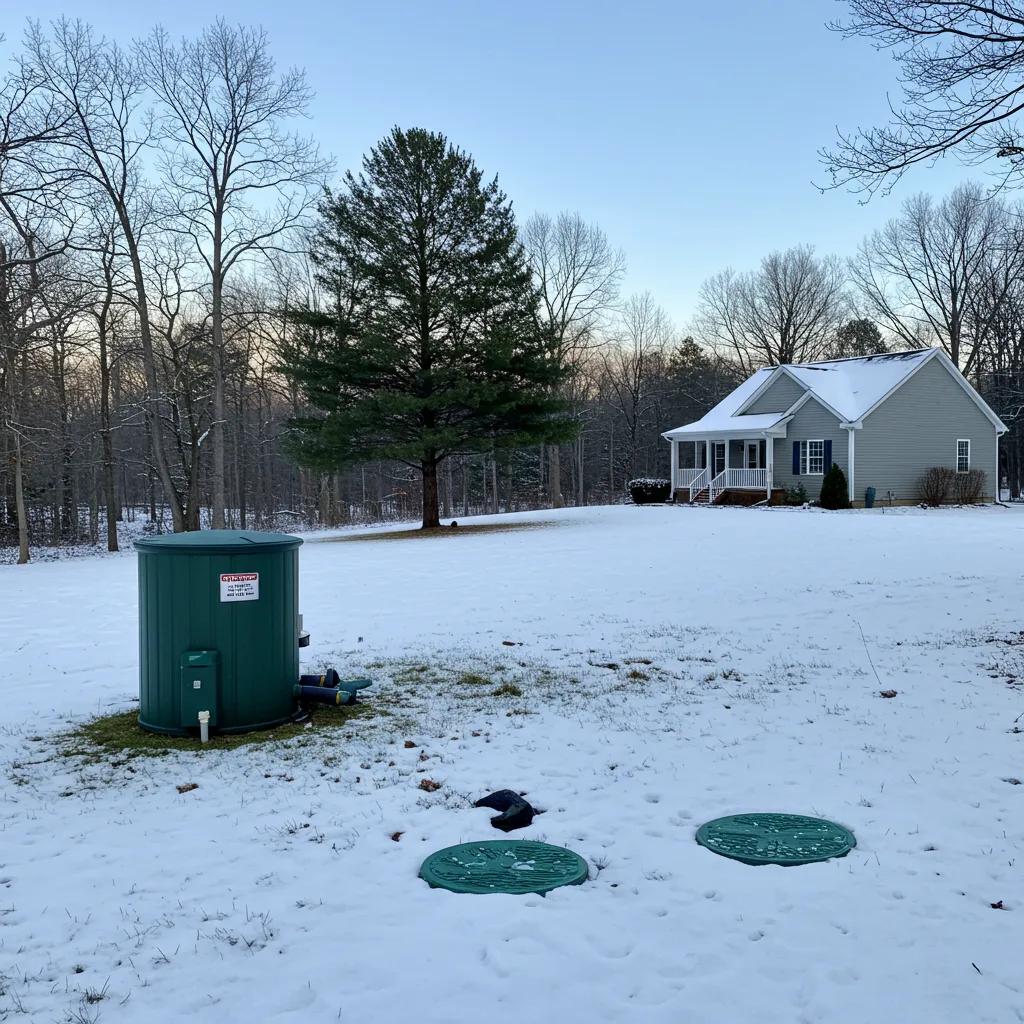Did you know a well-maintained septic tank can last for decades? The secret to this longevity rests in a straightforward maintenance routine that keeps the tank, drains, and associated plumbing in top shape.
This article will dive into the core components of your septic system’s functionality, illustrating how regular inspections can prevent water and waste management woes.
By committing to simple daily habits, scheduling periodic pumping, and knowing the warning signs of problems, you’re setting your system up for success.
If the dread of costly repairs has kept you up at night, let’s walk through a septic tank maintenance schedule that secures peace of mind and a well-functioning waste disposal mechanism for years to come.
How to Create a Perfect Septic Tank Maintenance Schedule
Key Takeaways
- Regular septic maintenance prevents emergencies and extends the system’s life
- Proper waste disposal and water conservation are crucial for septic health
- Keeping a detailed maintenance log aids in troubleshooting and proactive care
- Recognize warning signs like slow drainage to avoid severe septic problems
- Ensure septic system access for unobstructed maintenance and emergency services
Understand Your Septic System’s Components and Functionality

Ensuring your septic system operates smoothly starts with a clear grasp of its various parts and processes.
This crucial understanding spans knowing every aspect of your septic tank, how wastewater is processed, the pivotal role bacteria play in decomposing waste, and pinpointing where your septic drain field and septic tank are situated.
These insights are not just about hygiene and efficient sewage management—they’re key to prolonging the life of your system, preventing unexpected failures, and maintaining effective drainage.
Identify All Components of Your Septic System
Grasping the layout of your septic system is the first step to managing its upkeep. The system primarily consists of a septic tank, where solids settle, a pump to facilitate the flow, and a drain field where final treatment occurs.
Including a septic tank maintenance schedule in your routine maintenance can avert leaks that lead to toilet and drainage disruptions, ensuring your waste management keeps flowing seamlessly.
An expert’s eye can guide homeowners to locate each part and profess how they contribute to the system’s overall function. For instance, the pump, often a crucial yet overlooked component, must be inspected regularly to maintain its operational integrity.
A structured septic tank maintenance schedule is not just recommended—it’s a necessity for proactive waste management and averting plumbing emergencies.
Learn How Wastewater Moves Through the System
Once wastewater leaves your household via sinks, showers, or toilets, it enters your septic tank, where the real work begins. In this chamber, bacteria get to work breaking down solids, an essential process that prevents tank clogs and potential floods.
This treatment transforms the waste into effluent, a partially clarified liquid that is far less harmful to the environment and crucial for the overall health of the septic system.
Following this primary treatment in the tank, the effluent then travels to the drain field, where it undergoes further natural purification. Here, the soil acts as a filter, removing harmful bacteria and nutrients.
This step is vital to ensure that by the time wastewater reenters the groundwater, it is clean and does not pose any health risks to your household or the surrounding ecosystem.
Recognize Bacteria‘s Role in Breaking Down Waste
Bacteria within your septic system are the unseen heroes, tirelessly working to break down waste from your home. Whether it’s wastewater from your washing machine or grease scraped off dinner plates, these microorganisms are essential in converting solids to simpler forms.
Regular soil-based inspections are central to confirming these bacterial processes are on track, ensuring wastewater is properly treated before it reaches the drain field.
In essence, without the efficient breakdown of organic materials by bacteria, your septic system could face significant clogs and breakdowns. Think of bacteria as a natural recycling system: they take what comes from your kitchen and bathrooms, including grease and waste, and transform it into a substance that easily integrates into the soil.
It’s all the more reason why maintaining a healthy bacterial balance through proper system care is key to your septic tank‘s longevity.
| Septic System Component | Function | Maintenance Tips |
|---|---|---|
| Tank Bacteria | Break down solid waste | Reduce use of harsh chemicals that harm bacteria |
| Soil in Drain Field | Final filtration stage for wastewater | Regularly inspect and avoid overflow to prevent soil contamination |
| Grease Trap | Capture grease from kitchen waste | Clean periodically to prevent blockages |
Determine the Location of Your Septic Tank and Drain Field
Pinpointing the locations of your septic tank and drain field is not just smart—it’s crucial for preventing damage that can incur hefty repair bills. Keep in mind that things you send down your sink or toilet, including toilet paper, can impact these components.
Being aware of their placement helps you avoid planting trees whose roots could infiltrate and damage the system. It also aids in preventing excessive disposal of solid waste and feminine hygiene products that can overburden your tank.
Homeowners should be mindful of all that goes into their sinks and toilets, as what disappears from sight doesn’t vanish from their septic system.
A septic tank buried too close to the surface might rise after heavy rainfall, and a drain field hidden beneath your favorite garden spot could suffer from overlaid weight. Here are some practical tips for maintaining awareness of your system’s locations:
- Document the septic system’s map provided at installation for future reference.
- Avoid flushing thick toilet paper or solids that take longer to decompose.
- Steer clear of planting trees near the drain field to keep roots from causing havoc.
Your septic system works hard, quietly tucked away. Keep it that way with a schedule of routine inspections ahead.
Create a Regular Septic Tank Inspection Routine

Maintaining your septic system’s health is akin to a well-orchestrated routine, where each step—from identifying the ideal inspection frequency for your tank to following a thorough septic inspection checklist—is vital.
Ensuring objects like plant roots, paper products, oil, or diapers aren’t compromising your system’s efficiency is essential.
Documenting and reviewing findings after every inspection can reveal crucial patterns and conditions, guiding proactive maintenance and contributing to the longevity of your septic system.
Establish the Best Inspection Frequency for Your Tank
Determining the best inspection frequency for your septic tank is essential for keeping your system in tip-top shape.
Factors such as the number of inhabitants in your home, usage patterns of your dishwasher and taps, and the type of grease trap in your kitchen all influence how often you need to inspect.
A good rule of thumb is to have a professional check your system at least every three years, but homes with higher water usage may require more frequent inspections.
Regular inspections are key to spotting early signs of trouble, such as improper filtration or a full grease trap, before they escalate into costly repairs.
These checks can prevent kitchen waste from clogging your system and ensure everything is functioning as it should be. For the most efficient septic tank maintenance, consider the following checklist:
- Inspect and pump your tank every one to three years, depending on usage.
- Monitor water usage from household appliances like your dishwasher and ensure taps are leak-free.
- Have your grease trap cleaned regularly to avoid kitchen waste buildup and ensure proper filtration.
Use a Comprehensive Septic Inspection Checklist
Adhering to a detailed septic inspection checklist can make a world of difference in safeguarding the efficiency of your septic system.
For instance, regular checks for signs of backup and assessing the levels of scum and sludge can pre-empt difficulties, while inspecting for proper separation of cooking oil, grease, and things that shouldn’t be flushed—like non-biodegradable wipes or excessive quantities of laundry lint—protects pipes and the drain field from clogging.
This vigilance is crucial as unchecked materials can create blockages that result in costly repairs.
The expert eye of a septic system professional is invaluable in spotting potential issues with maintenance that a layperson might overlook, such as unusual fluctuations in tank water levels or subtle signs of soil contamination near the drain field.
These professionals can also offer personalized advice on managing wastewater from cooking and laundry to extend the system’s life.
Proactive measures include avoiding the introduction of detrimental substances and scheduling regular maintenance checks to preserve a well-functioning septic system.
Document and Review Findings After Each Inspection
Keeping a detailed record of each septic inspection can expose patterns in the buildup of organic matter and scum over time. Smart Septic Pros recommend that homeowners review such reports to understand the frequency and efficiency of required septic service interventions.
This ongoing documentation becomes a blueprint for maintaining an effective septic system, ensuring a consistent approach to septic pumping and timely identification of potential issues.
This proactive review process highlights the importance of each septic service appointment. A comparison of past and current inspections sheds light on the condition of the septic system and helps predict its future needs.
By staying informed about the levels of solids and the performance of wastewater treatment, homeowners are equipped to make educated decisions backed by a historical account from their own system’s record of maintenance and performance.
Inspections keep your septic in check, but daily actions make a lasting difference. Let’s find out how simple habits can safeguard your system’s future.
Practice Daily Habits to Protect Your Septic System

Maintaining a healthy septic system starts with everyday actions. Effective septic tank cleaning services recommend disposing of waste properly to prevent clogs, conserving water to ease strain on your system, steering clear of harmful chemicals in drains, and using only septic-safe products for cleaning.
Addressing sludge buildup, protecting groundwater quality, and ensuring your sump pump functions optimally are key. These routine measures pave the way towards a robust septic service checklist, crucial for a thriving system.
Dispose of Waste Properly to Prevent Septic Clogs
Mindful disposal of waste isn’t just about keeping a clean home; it’s a critical step in preventing septic clogs and safeguarding environmental integrity.
The United States Environmental Protection Agency emphasizes the importance of avoiding certain items such as paint, household chemicals, and other contaminants in the septic system.
By doing so, homeowners ensure continuity and accessibility for essential maintenance, while averting the potential hazard these substances pose to their property and the environment.
When it comes to maintaining a septic system, every household should regard their plumbing as a gateway to their septic tank rather than a disposal site. Responsible management of waste includes being cautious about what goes down the drain.
Prohibiting the flushing of paint, oils, and harsh chemicals prevents the clogging of septic components, thereby extending the system’s lifespan and ensuring it runs effectively, free from unnecessary and often costly intervention.
Conserve Water to Reduce Stress on the System
Conserving water is a simple yet highly effective strategy to minimize the burden on your septic system. Every drop saved means less wastewater treatment needed, reducing the risk of unpleasant odors and the potential for system overload.
Adopting water-saving habits, like fixing leaks promptly, can prevent the unnecessary flow of water—and subsequently, human and biodegradable waste—into your septic tank, elongating its operative life.
Sensible water usage goes hand in hand with septic system care. For example, opting for eco-friendly soap and detergents minimizes chemical impact on the system’s delicate microbial balance.
This daily commitment to conservation can significantly reduce the volume of water entering the system, ensuring its components function efficiently and extending the intervals required between maintenance services:
- Install low-flow fixtures to reduce water consumption.
- Spread out laundry days to avoid excessive water from washing cycles.
- Redirect rainwater away from the drainfield to maintain its absorption capacity.
Avoid Introducing Harmful Chemicals Into Drains
Keeping harm at bay from your septic system means vigilance against flushing medications or pouring harsh chemicals down the drains.
Introducing items like expired meds or paint into your septic can create a real hazard, not only compromising your system but also potentially seeping into groundwater and affecting local irrigation.
Smart septic owners understand that what goes down eventually comes around, affecting fat breakdown and overall system health.
People often overlook the risk that common household substances like cleaning agents and personal care products pose to their septic systems. To avoid disrupting the vital bacterial balance, it’s wise to steer clear of sending chemicals, especially antibiotics, down the sink or toilet.
These practices safeguard the integrity of the septic system and ensure that fat and other waste are decomposed effectively, maintaining a septic tank primed for longevity.
Use Only Septic-Safe Cleaning Products at Home
Adopting the use of septic-safe cleaning products is a wise step in ensuring the longevity of your septic system.
Such products are designed to prevent the disruption of essential bacterial activities that are critical for optimal biodegradation within the tank. This practice not only aligns with water conservation efforts but also helps avert potential sanitation emergencies that might stem from system malfunctions.
It’s easy to overlook, but the choices made in aisle five of the grocery store can have a significant impact on septic system health.
When residents in the United States select cleaners that are septic-friendly, they are actively contributing to the sustainability of their system by minimizing harsh chemicals that can hinder the wastewater treatment process, thus maintaining the sanitation and efficiency of their home’s waste management system.
Daily habits form the front line of defense for your septic system. Yet, time marches on, and the inevitable need for periodic maintenance arises – let’s prep for the next crucial step.
Schedule Periodic Septic Tank Pumping and Cleaning

Maintenance is key to ensuring the longevity of your septic system. Calculating the appropriate intervals for pumping based on household usage helps maintain water efficiency and prevent system overload.
Relying on qualified professionals for pumping services guarantees that each step—from preparation to cleaning—is handled with care.
Homeowners should prepare their property for easy septic tank access, understanding the role enzymes play in the process and how compost-like byproducts are responsibly managed post-evaporation. Familiarity with these steps simplifies the path to a healthy septic system.
Calculate Pumping Intervals Based on Household Use
Determining the right frequency for septic tank pumping is essential for maintaining environmental health and preventing septic system mishaps.
Experts advise that the average household should consider pumping every three to five years, but this varies based on the number of residents and daily water usage.
Keeping track of these variables helps in tailoring a maintenance schedule that deals effectively with the wastewater and solid matter, keeping your system running smoothly for years.
Ignoring the need for periodic pumping can lead to a buildup of sludge, affecting the system’s efficiency and leading to potential health hazards.
Contact Smart Septic Pros for a professional assessment to establish a custom pumping interval for your home. By taking into account the unique demands on your septic system, the pros ensure that both your septic health and home environment are safeguarded against the risks of an overburdened system.
Hire Qualified Professionals for Pumping Services
When it comes to ensuring the longevity of your septic system, Smart Septic Pros understands the importance of relying on qualified professionals for pumping services.
Their team of experts is trained to handle commercial septic pumping and residential tank cleaning with precision, safeguarding your system against premature failure. By adhering to a carefully crafted pumping schedule gguide, they keep your maintenance on track and disruptions to a minimum.
Septic maintenance regularly highlight the significance of professional oversight, especially in times of an unforeseen septic emergency.
| Service | Benefits |
|---|---|
| Professional Pumping | Extends lifespan, prevents blockages |
| Regular Maintenance | Reduces emergencies, maintains efficiency |
| Emergency Response | Quick resolution, minimizes damage |
Prepare Your Property for Septic Tank Access
Ensuring straightforward access to your septic tank is a crucial step before any maintenance or inspection is performed. Homeowners should check to guarantee that the area over the septic system is clear of obstructions such as vehicles, equipment, or large debris.
This simple act of preparation allows local septic installers and maintenance experts to perform their work swiftly and without hindrance, supporting the longevity of your system.
One of the common challenges for local septic installers is encountering landscaping or structures unintentionally concealing or blocking access to the septic tank.
As a septic owner, facilitating easy entry can be as simple as marking the tank‘s location and keeping the path to it clear. This proactive approach saves time and resources during pumping or emergency services, ensuring the health and optimal function of your septic system.
Understand the Pumping and Cleaning Process Steps
Understanding the steps involved in septic tank pumping and cleaning eliminates guesswork and prepares homeowners for regular maintenance.
Initially, professionals will locate the tank, often buried underground, and remove the lid to begin the pumping process. They then employ a high-powered hose to evacuate the contents, diligently separating liquids from solids and transporting waste to a designated treatment facility.
The cleaning phase follows, where technicians flush the system’s interior, removing any remaining sludge and ensuring all tank components are free from debris. This meticulous clean-out prevents build-up that can lead to backups, protecting the tank‘s integrity and optimizing system performance for the long haul:
| Process Step | Description | Outcome |
|---|---|---|
| Pumping | Removal of all tank contents using specialized equipment. | Avoids excessive accumulation, reduces risk of failure. |
| Cleaning | Detailed cleansing of tank’s interior and components. | Enhances system efficiency, prolongs lifespan. |
Regular septic servicing wards off trouble. Yet, vigilance remains your ally as even well-kept systems whisper warning signs.
Monitor Warning Signs of Septic System Problems

Maintaining a septic system for the long haul requires vigilance. Spot the early warning signs, such as slow drains or plumbing backups, to prevent larger issues.
Homeowners should also stay alert to any sewage odors, as these can indicate a fault in the system. Noticeable standing water over the drain field area is another red flag. Taking quick action in response to these signs is essential to keep your septic system in good health.
Identify Slow Drains or Plumbing Backups Early
Noticing your drains are taking longer to clear than usual can be an early indicator that your septic system needs attention.
Whether it’s a gurgling sound from your bathroom sink or a shower that’s slow to drain, these warning signs can hint at a blockage that, if ignored, could lead to more severe septic system problems.
Plumbing backups are more than just an inconvenience; they’re a red flag signaling potentially urgent septic system distress. Quick identification and resolution by septic professionals can prevent the problem from escalating, protecting your home from the damage and discomfort of an overflowing or malfunctioning septic tank.
Detect Sewage Odors Inside or Outside Your Home
One of the unmistakable warning signs of septic system trouble is the presence of unusual, pungent odors either within your home or outside in the proximity of your drain field.
These sewage smells can indicate a septic tank that’s either too full or not processing waste correctly, signaling it’s time to reach out to septic specialists like Smart Septic Pros for immediate analysis and action.
If homeowners catch a whiff of this potent reminder, prompt response can avert further complications like system backups or health hazards. Regularly scheduled maintenance and adherence to professional guidelines can reduce occurrences of such foul scents, maintaining a healthy balance within your septic system’s ecosystem.
| Warning Sign | Possible Cause | Immediate Action |
|---|---|---|
| Sewage Odor Inside Home | Full septic tank or blocked vents | Inspect and pump the tank, check and clear vents |
| Sewage Odor Outside | Failing drain field or overflowing tank | Schedule a professional septic inspection |
Look for Standing Water Over the Drain Field Area
Observing standing water above the drain field can be a clear indicator that your septic system is not functioning properly. This often occurs when the septic tank is overwhelmed, leading to an inability to properly absorb and filter wastewater through the soil.
It’s essential for homeowners to be vigilant and recognize pooling water as a sign to initiate immediate maintenance measures. Addressing this issue promptly can prevent further damage to the septic system and avoid costly repairs:
- Check for compacted soil or over-saturation in the drain field area.
- Reduce water usage to alleviate stress on the septic system.
- Consult with septic service experts to assess and remedy the situation.
Respond Quickly to Any Septic System Issues
When septic system issues arise, acting swiftly can mean the difference between an easy fix and a full-scale emergency. Homeowners need to address signs such as slow drainage or the unpleasant whiff of sewage without delay.
Quick action following the discovery of any septic issue is more than advisable – it’s essential for the health of the system. For example, a septic alarm sounding is a clear call to immediate service to prevent backups and overflows.
By staying on top of these signals, septic owners can rest assured their systems receive the care necessary to avoid interruptions in service:
- Check for pooling water or foul odors indicating urgent septic concerns.
- Engage septic professionals at the first hint of system distress.
- Establish a responsive maintenance routine for early detection.
Watching for the signs keeps trouble at bay. Now, to stay ahead, mark each septic check and fix on your calendar.
Keep Records of Septic Maintenance and Service

Achieving a septic system that stands the test of time can be as simple as keeping a detailed account of its maintenance.
Compiling documentation of all septic-related activities, maintaining up-to-date contact information for service providers, and securely storing maintenance records are foundational steps.
This section looks into the strategies homeowners can implement to ensure a seamless maintenance experience by having a comprehensive historical reference at their disposal. Each relevant topic demonstrates how careful record-keeping can be a powerful tool in the longevity and health of septic systems.
Compile All Documentation of Septic Activities
Keeping a logbook of septic system activities shouldn’t be overlooked. This practical habit keeps tabs on everything from routine inspections to emergency interventions.
It’s critical for homeowners to note the dates of septic pumping, inspections, and any repairs, linking them back to the health and functionality of their system. Keeping these records well-organized can also assist professionals in diagnosing issues and planning future maintenance.
Documenting the intricacies of your septic system’s care pays dividends in the long term. For instance, if you were to sell your property, a comprehensive maintenance log can be a strong selling point, assuring potential buyers of the system’s reliability.
This level of diligence also enables you to spot patterns and plan ahead for services, ensuring your system remains robust:
- Record the frequency of septic tank pumping and expected next service.
- Note any changes post-service that may affect the system’s performance.
- Maintain receipts and details of any parts replaced or repairs done.
Maintain Contact Information for Service Providers
Maintaining up-to-date contact information for reliable septic service providers forms a critical link in the chain of effective septic system management.
The practice of keeping this data handy not only eases the coordination of routine checks but also ensures timely response during unforeseen septic challenges. Homeowners benefit from this preparedness, which translates to quicker resolutions and reduced risk of damage to their septic systems.
By establishing a rapport with skilled septic technicians, homeowners are one step ahead when it comes to system upkeep. This connection makes scheduling regular inspections or addressing emergency issues a seamless process.
Moreover, it assures them that a trusted professional is always within reach, ready to offer expert advice and service to keep their septic tank functioning optimally for years to come.
Store Maintenance Records for Future Reference
Storing maintenance records for future reference might sound like a small task, but it’s a significant step in prolonging the healthy lifespan of your septic system.
Detailed records enable you to track the history of your septic tank‘s performance, spotlighting the effectiveness of past services and guiding future care decisions.
Keeping this information readily available means that, should an issue arise, you’ll have a clear timeline of maintenance work, which is invaluable for troubleshooting and resolving problems promptly.
Imagine you need to pinpoint when your last pump-out took place or assess the frequency of service visits; well-maintained records make this a breeze.
They provide a tangible storyline of your septic system’s health, and should you decide to sell your home, they serve as proof of diligent septic maintenance to potential buyers. It’s this kind of attention to detail that not only extends the life of your septic tank but also enhances its dependability.
| Date | Service Performed | Service Provider | Notes |
|---|---|---|---|
| 01/03/2021 | Septic Tank Pumping | Smart Septic Pros | No issues noted, system functioning well |
| 07/11/2022 | Inspection and Cleaning | Smart Septic Pros | Recommended increasing pumping frequency due to household size |
Frequently Asked Questions

How often should a septic tank be inspected?
Septic tanks typically require inspection every three to five years, depending on usage and household size, to ensure optimal function and prevent issues.
Can daily habits affect septic tank health?
Yes, everyday practices like water conservation, careful waste disposal, and avoiding chemical drain cleaners can significantly influence septic system health and function.
What should never be flushed down a septic system?
Avoid flushing non-biodegradable items, chemicals, oils, wipes, and feminine hygiene products down your septic system to prevent clogs and maintain its health.
When is septic tank pumping necessary?
Septic tank pumping is essential every 3-5 years, or when symptoms like slow drains or foul odors suggest a full tank.
What are early signs of septic system failure?
Early signs of septic system failure include foul odors, slow drains, gurgling sounds in plumbing, water pooling near the drain field, and backed-up sewage.
Conclusion
Maintaining a regular septic tank maintenance schedule is crucial for extending the life of your system and avoiding costly repairs. With the right plan in place, you can ensure your septic system functions efficiently for years to come.
For reliable and professional septic services, choose Smart Septic Pros. Call us today at 678-993-4545 or visit our website to fill out the contact form and schedule your service. Let us help you keep your septic system in top condition!



